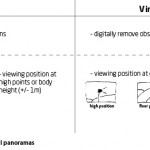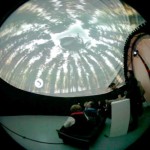Armin’s page
Interface for immersive photo-based virtual tours in a projection dome
 Technical requirements and resources have recently come to a level where an affordable fully projected hemi-spherical dome system can be realized without the use of specialised mirrors or lenses.
This opens up the possiblity for them to be used more widely for temporary immersive installations for exhibitions. As content, photo-based virtual tours are one scenario this can be used for. Screen-based virtual tours have existed for a long time (at least 10 years), but lack a degree of immersion, which this system can offer.
Using the dome projection system as a prototype the goal is to utilize it for presenting virtual tours. As the setup is vastly different to a computer screen with a mouse and keyboard, new interfaces have to be designed to both symplify and demystify the experience, which is still new to most people.
Technical requirements and resources have recently come to a level where an affordable fully projected hemi-spherical dome system can be realized without the use of specialised mirrors or lenses.
This opens up the possiblity for them to be used more widely for temporary immersive installations for exhibitions. As content, photo-based virtual tours are one scenario this can be used for. Screen-based virtual tours have existed for a long time (at least 10 years), but lack a degree of immersion, which this system can offer.
Using the dome projection system as a prototype the goal is to utilize it for presenting virtual tours. As the setup is vastly different to a computer screen with a mouse and keyboard, new interfaces have to be designed to both symplify and demystify the experience, which is still new to most people.
 My project will lead to the design of such an interface, using the possibilities of virtual tours and providing a fun and functional user experience.
My starting question for this user-centered excercise was:
My project will lead to the design of such an interface, using the possibilities of virtual tours and providing a fun and functional user experience.
My starting question for this user-centered excercise was:
How do people behave and navigate in real viewpoints and virtual tour viewpoints?
Methods – Orientation in real and virtual viewpoints
A user observation has been conducted in 3 steps. Step 1: Shadowing technique to observe a user in a real location. This included identifying landmarks on a map, orientation excercise, viewing of a landmarks from a single spot using public pay-for binoculars. Step 2: Observation and screen-capture when using Google Street View. Excercise to locate…
Insights from user interview
Interview session following the user-centered observation excercises in the previous video. Christian Lange talks about his experiences, using different interfaces and navigating in Virtual Tours. This was tested using Google Street View and a web based virtual tour by Ghosts in Armour (www.ghostsinarmour.com/popup01.html) These are the the key parts of Interview from which insights can…
Analysis – Comprehending Orientation
From the user observation and subsequent interview it is apparent that in real as well as virtual viewpoints a clear comprehension of the orientation in respect to known features is necessary. Real World In real environments this can be done by referencing known landmarks, comprehending signs or using a map. Other factors could include previous…
Analysis Part II – Navigating between viewpoints

In the real world when moving between 2 distinct viewpoints 2 things happen: 1. passage of time 2. travelling of a distance Dictated by the current technology, photographic virtual tours are limited to single viewpoints, rather then fluid motion like in a computer game. In Google Street view this is compensated partly by increasing the…
Comparison – Real vs. Virtual (Digital)

Beyond Geolimitation From the insights gathered I started a comparison between real viewpoints and the possibilities of Virtual or digital technologies. The first aspect i looked at was location. Here there are 2 advantages of the virtual imaging compared to real life. Firstly in many viewpoints there are unwanted obstructions to the view. In digital…
Further investigations & Research Questions

After realizing certain advantages of using Immersive Virtual Tours, using this in exhibition settings requires the interaction with those factors (space, time, extension). Further investigations would look at peoples perception of time and space between viewpoints. For example a person could be blindfolded and led between 2 viewpoints. Then a person could be led between…